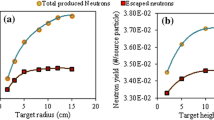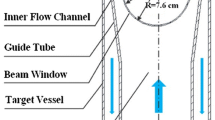Abstract
A number of neutronics of JNIR big uranium target are simulated towards the planning of experimental investigations aimed to the transmutation of radioactive waste. Integral data of the neutron yield and energy spectra are given for several homogeneous spallation targets which are planned to be used as insertions in uranium blanket. Combined spallation targets are also of interest, because it can help to obtain an optimal neutron energy spectrum for effective burning of long-lived fission products and minor-actinides. For this purpose, uranium-beryllium dual insertion was also considered and described in this work.








Similar content being viewed by others
REFERENCES
A. I. Dubrouski and A. I. Kiyavitskaya, “Simulation of neutronics of an accelerator driven system,” Phys. Part. Nucl. Lett. 17, 19–26 (2020).
Geant4 Collaboration Physics Reference Manual, Release 10.6. https://Geant4.Web.Cern.Ch/Support/User_documentation. Accessed February 01, 2020.
M. S. Zucker et al., “Spallation neutron production measurements,” in Proceedings of the 2nd International Conference on Accelerator Driven Transmutation Technologies and Applications (ADTTA), Kalmar, Sweden, June 1996, Vol. 1, pp. 527–533.
A. I. Kievitskaia et al., “Accelerator molten salt breeder as fissible producing component of THORIUM-NES concept for energy production and transmutation of plutonium,” in Proceedings of the 8tht International Conference on Emerging Nuclear Energy Systems ICENES’96, Obninsk, Russia, June 24–28, 1996, pp. 564–571.
T. Goorley et al. (MCNP Monte Carlo Team, X-5), “Release of MCNP5_RSICC_1.30,” Report LA-UR-04-8086 (Los Alamos Natl. Lab., Los Alamos, 2004).
H. Huges et al., “MCNPX - the LAHET/MCNP code merger,” Report No. LA-UR-97-1638 (Los Alamos Natl. Lab., Los Alamos, USA, 1997), p. 26.
A. A. Baldin, A. I. Berlev, I. V. Kudashkin, G. Mogildea, M. Mogildea, M. Paraipan, and S. I. Tyutyunnikov, “Simulation of neutron production in heavy metal targets using Geant4 software,” Phys. Part. Nucl. Lett. 13, 391–402 (2016).
Y. Malyshkin et al., “Modeling spallation reactions in tungsten and uranium targets with the Geant4 toolkit,” EPJ Web of Conf. 21, 10006 (2012).
A. I. Kievitskaya, “Mesocatalytic hybrid reactor. Neutronics and energy balance,” Cand. Sci. (Phys. Math.) Dissertation (Minsk, 1991), p. 125.
S. E. Chigrinov, I. Rakhno, and H. Kiyavitskaya, “The code SONET to calculate accelerator driven system performance,” in Proceedings of the 3rd International Conference on Accelerator Driven Transmutation Technologies and Application (99’ADTTA), Praha, Pruhonice, Czech Republic, June 7–11, 1999, paper MO-O-C12, pp. 1–8.
S. Chigrinov, I. Rakhno, and A. Kievitskaia, “Monte Carlo calculation of relativistic protons interaction with extended targets and transmutation of iodine-129 and neptunium-237,” in Proceedings of the International Conference on the Physics of Nuclear Science and Technology, New York, USA, October 5–8, 1998, pp. 1455–1461.
Author information
Authors and Affiliations
Corresponding author
Rights and permissions
About this article
Cite this article
Dubrouski, A.I., Kiyavitskaya, A.I. & Tyutyunnikov, S.I. Simulation of an Accelerator Driven System with Different Spallation Targets. Phys. Part. Nuclei Lett. 18, 27–35 (2021). https://doi.org/10.1134/S1547477121010052
Received:
Revised:
Accepted:
Published:
Issue Date:
DOI: https://doi.org/10.1134/S1547477121010052




